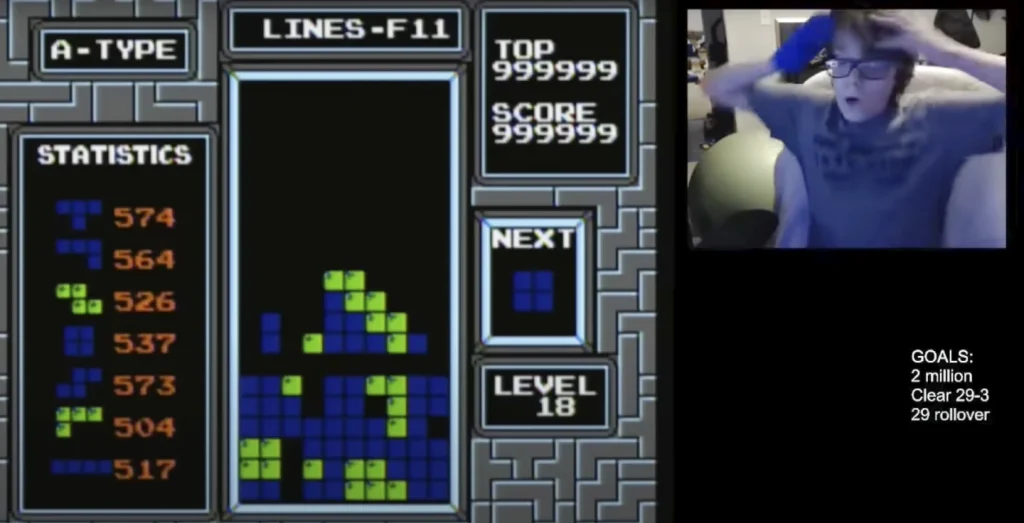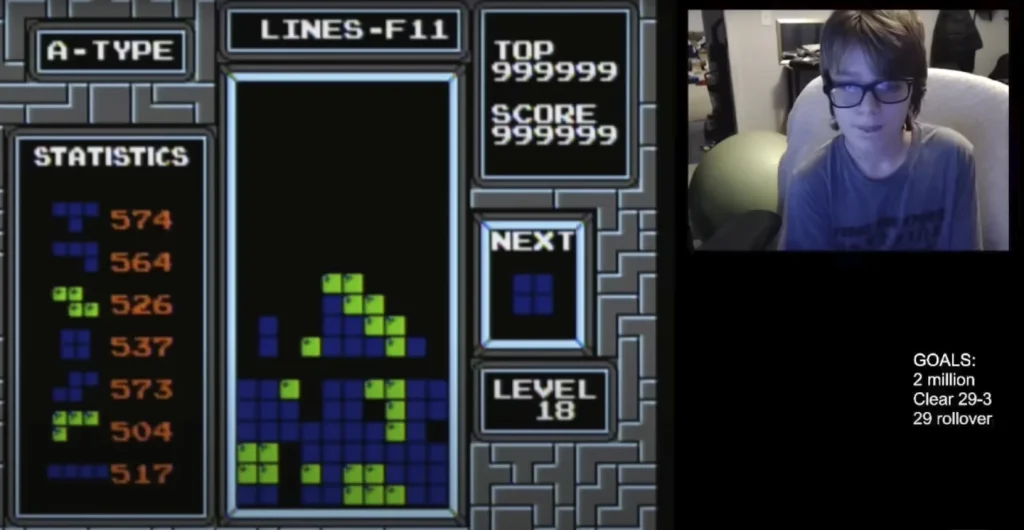The recent accomplishment of 13-year-old Willis Gibson, also known as “blue scuti” in the gaming community, has brought the classic falling-block video game Tetris into the spotlight once again.
Gibson has achieved the remarkable feat of becoming the first player to officially “beat” the original Nintendo version of Tetris by reaching what gamers refer to as a “kill screen,” a point at which the Tetris code glitches and crashes the game.
While this achievement may not conform to traditional notions of victory based solely on high scores, it holds significant value within the realm of video games, where players constantly strive to push the boundaries of hardware and software capabilities.
The notion of “beating” Tetris is particularly noteworthy due to the game’s reputation for being virtually unbeatable.
Unlike many other games, Tetris lacks a scripted ending, with the iconic four-block shapes continuously falling regardless of a player’s skill level in stacking them to form disappearing rows.
Consequently, top players have historically sought to prolong their winning streaks by reaching ever higher levels, only to ultimately succumb to the game’s unyielding nature.
Gibson’s groundbreaking accomplishment has shattered the widely held belief that Tetris is insurmountable, garnering widespread attention and admiration within the gaming community.
The significance of Gibson’s achievement extends beyond mere gameplay, as it serves as a testament to the perseverance and ingenuity of dedicated gamers.
By pushing the original Nintendo version of Tetris to its limits, Gibson has not only made history but has also highlighted the potential for innovation and breakthroughs within the realm of classic video games.
His success underscores the enduring appeal of Tetris and the enduring allure of conquering seemingly insurmountable challenges.
Gibson’s feat has reignited interest in Tetris, captivating the imaginations of both seasoned gamers and newcomers alike.
It has sparked discussions about the nature of victory in video games, prompting a reevaluation of traditional benchmarks for success.
Furthermore, it has inspired a new wave of enthusiasm for exploring the uncharted possibilities within established gaming landscapes.
In conclusion, Willis Gibson’s groundbreaking accomplishment in “beating” the original Nintendo version of Tetris by reaching the elusive “kill screen” represents a monumental triumph within the gaming world.
His achievement has shattered long-held perceptions of Tetris as an unbeatable game and has reinvigorated the gaming community’s appreciation for the enduring appeal of classic video games.
Gibson’s feat serves as a testament to the resilience and creativity of gamers and has sparked renewed interest in exploring the uncharted potential of iconic gaming experiences.
The achievement of triggering a kill screen on Level 157 in Tetris, accomplished by a player named Willis on December 21, has sparked widespread interest and admiration within the gaming community.
This remarkable feat represents a significant milestone in the history of the iconic game, pushing its limits beyond what was previously thought possible.
The makers of Tetris, acknowledging the magnitude of this accomplishment, have extended their congratulations to Willis, recognizing the unparalleled nature of his achievement.
Maya Rogers, the CEO of Tetris, expressed her admiration for Willis’ extraordinary feat in a statement, emphasizing the significance of this achievement in defying the established limits of the game.
As Tetris approaches its 40th anniversary, Willis’ victory is hailed as a monumental achievement, underscoring the enduring appeal and ongoing evolution of this legendary game.
The journey leading up to Willis’ groundbreaking accomplishment has been marked by significant challenges and gradual progress.
Early on, the Tetris community encountered difficulties in reaching higher levels, with players often becoming stuck in the 20s and 30s due to a lack of knowledge regarding advanced techniques.
David Macdonald, a prominent gaming YouTuber with extensive experience chronicling the gaming industry, highlighted the initial struggles faced by players in navigating the complexities of the game.
One particular obstacle that proved to be especially formidable was Level 29, where the increasing speed of falling blocks outpaced the responsiveness of the in-game controller, presenting a significant barrier to progress.
However, the tenacity and ingenuity of players eventually led to the discovery of innovative techniques that enabled them to overcome these challenges and make significant headway in the game.
Macdonald’s detailed video documenting Willis’ victory provides a comprehensive account of the evolution of Tetris gameplay, offering insights into the strategic breakthroughs and pivotal moments that have shaped the game’s trajectory.
Notably, in 2011, the introduction of “hypertapping” as a technique allowed players to achieve Level 30 by employing rhythmic finger movements to manipulate the game controller at a faster pace than the game’s inherent speed.
This groundbreaking approach facilitated further advancements, culminating in players reaching Level 35 by 2018, before encountering a formidable obstacle that seemed insurmountable.
Willis’ triumph on Level 157 represents a culmination of years of dedication, perseverance, and strategic innovation within the Tetris community.
His achievement serves as a testament to the enduring appeal of classic games and the boundless potential for pushing the boundaries of established norms within the gaming world.
As Tetris continues to captivate audiences and evolve with the passage of time, Willis’ victory stands as a testament to the indomitable spirit of gamers and the limitless possibilities for transcending perceived limitations within the realm of gaming.
In conclusion, the significance of Willis’ accomplishment in triggering a kill screen on Level 157 of Tetris cannot be overstated.
This monumental achievement not only symbolizes a triumph over the game’s inherent challenges but also underscores the unwavering determination and innovation that define the gaming community.
As Tetris embarks on its 40th anniversary, Willis’ victory stands as a testament to the enduring legacy and ongoing evolution of this iconic game, inspiring future generations of players to continue pushing the boundaries of what is deemed possible within the realm of gaming.
The year 2020 marked a significant milestone in the world of gaming as a dedicated player ingeniously combined a multifinger technique, originally employed in arcade video games, with a strategic finger placement on the controller, resulting in a revolutionary approach known as “rolling.”
This innovative technique not only enhanced speed but also facilitated the achievement of Level 95 by a single player in 2022.

However, this groundbreaking advancement was not without its share of unforeseen obstacles. The original developers of Tetris had never anticipated players pushing the game’s limits to such extremes, leading to the emergence of peculiar challenges at higher levels.
One particularly daunting issue surfaced with the game’s color palette, which traditionally cycled through 10 easily distinguishable patterns.
Upon reaching level 138, an unexpected phenomenon occurred: random color combinations began to appear, some of which significantly hindered the ability to differentiate the blocks from the game’s black background.
Two particularly vexing patterns, one characterized by a dim amalgamation of dark blues and greens, later labeled “Dusk,” and the other composed of black, gray, and white blocks, dubbed “Charcoal,” posed formidable challenges for players.
Coupled with the escalating duration of games, which could extend to 40 minutes or more, progress was once again impeded.
It was not until the emergence of a Tetris-playing AI program named StackRabbit that this impasse was overcome.
StackRabbit, operating on a modified version of Tetris, managed to reach Level 237 before crashing the game, thereby achieving a milestone that surpassed human players’ accomplishments.
While its findings were not immediately transferable to the human-played game, they unequivocally demonstrated that game-ending glitches could be triggered by highly specific events, such as the types of block pieces in play or the number of lines cleared simultaneously.
The breakthroughs made by StackRabbit prompted human players to undertake the arduous task of mapping out all potential scenarios that could lead to game crashes in the original version.
These crashes typically occurred when the game’s decade-old code lost its place and began reading instructions from incorrect locations, resulting in erroneous input.
A concerted effort, galvanized by StackRabbit’s experiences, culminated in the compilation of a comprehensive spreadsheet detailing the levels and specific conditions most likely to precipitate a crash.
This collective endeavor ultimately inspired Willis to embark on his quest for the record. Even he was taken aback when, at Level 157, he inadvertently crashed the game.
In a live-streamed video, his shock is palpable as he appears to hyperventilate, repeatedly exclaiming, “Oh my God,” while clutching his temples and expressing concern about potentially passing out. After attempting to regulate his breathing, he finally utters, “I can’t feel my fingers.”
In conclusion, the evolution of Tetris, from the introduction of the “rolling” technique to the unearthing of unforeseen glitches and the subsequent collaborative efforts to overcome them, underscores the remarkable journey of this iconic game.
The fusion of human ingenuity and technological prowess has not only pushed the boundaries of gameplay but has also revealed the intricacies and challenges inherent in the pursuit of gaming excellence.
As Tetris continues to captivate and challenge players, it stands as a testament to the enduring allure of video games and the unyielding spirit of those who seek to conquer their virtual realms.
